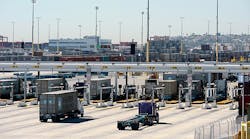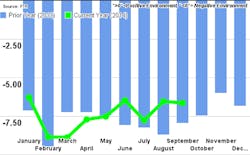It’s been a tough couple years for shippers, but lately it’s been downright degrading… at least according to the Shippers Conditions Index (SCI) maintained by FTR. The latest monthly SCI score (for September) came in at -6.6, which reflects “continued capacity shortages that degrade service and push rates higher,” according to FTR.
The current scenario looks like this: sustained capacity tightness, coupled with announced pay increases for truck drivers, will result in the cost to ship goods remaining high. There may be a slowdown in freight tonnage during the winter months (which is to be expected), but that will offer just a temporary reprieve. FTR expects the SCI to remain about where it is for the foreseeable future.
Any score under 0.0 indicates a less-than-ideal environment for shippers, and the closer that number gets to -10, the more critical the conditions for shippers.
“While truck capacity hasn’t been as bad as we saw during last winter, it has remained tight and, as a consequence, rates have been elevated throughout the year,” observes Jonathan Starks, FTR’s director of transportation analysis. In recent weeks, shippers’ concern has moved from capacity on the roads to problems at the ports, he notes, due to port congestion as well as import surcharges.
Importers, he adds, “are dealing with delays in getting goods and additional costs on top of that. If a resolution of the West Coast labor dispute or a winter slowdown in freight doesn’t ease the situation, we could have a very tough operating environment in early 2015 for those that are dependent on those ports.”
But wait, it gets worse. “Truck fleets are getting confident in their ability to secure rate increases for next year and have been busy ordering new trucks for delivery in 2015,” Starks notes. “October truck orders were for over 45,000 units—the second highest total on record. However, we don’t believe that it will be enough to significantly alter the supply and demand balance. The market will soften as we head into the new year (weather permitting) but will tighten again as soon as spring appears. Shippers need to be prepared for another year of dealing with tight capacity and increasing rates, no matter the mode.”
Meanwhile, Rosalyn Wilson, a transportation analyst with Parsons and the author of the annual State of Logistics Report, has taken a look at conditions near to real-time in her analysis of the Cass Freight Index report, and she sums up the situation in one word: turmoil. “The congestion and slowdown at the ports deteriorated over the month of October, and has reached critical proportions, particularly at the Ports of Los Angeles and Long Beach.” In particular, toy retailers have been hit hard, with the underlying problem being supply issues. There simply aren’t enough trucks right now to move the containers from the ports to distribution centers to retail stores, Wilson points out.
The good news, Wilson says, is that “the economy is still strengthening, with growth in areas that are good for the freight community, such as residential construction.” The bad news, though, is that shippers should expect to see transportation rates continue to increase.
Photo of Port of Los Angeles by Kevork Djansezian / Getty Images.





